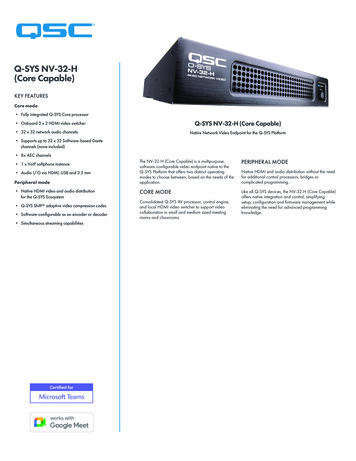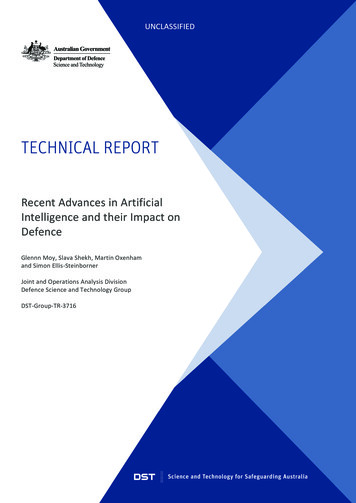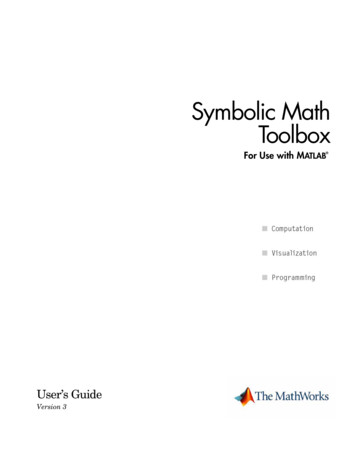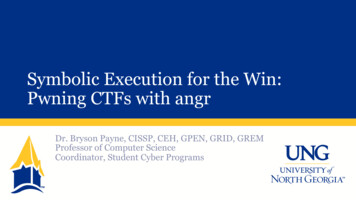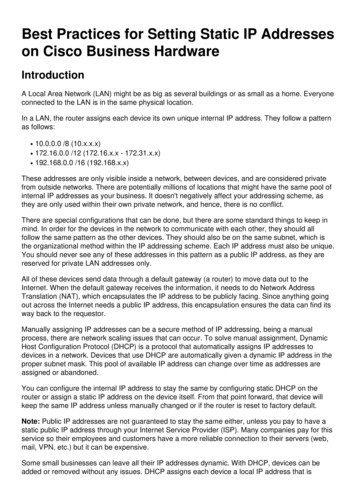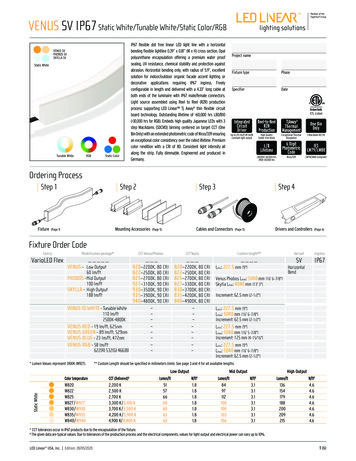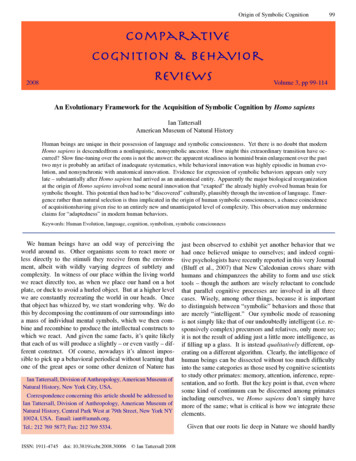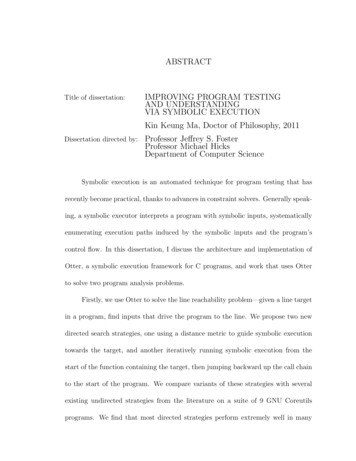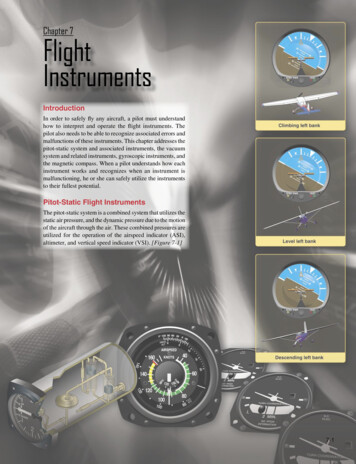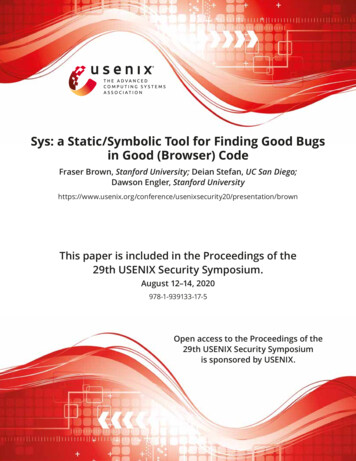
Transcription
Sys: a Static/Symbolic Tool for Finding Good Bugsin Good (Browser) CodeFraser Brown, Stanford University; Deian Stefan, UC San Diego;Dawson Engler, Stanford security20/presentation/brownThis paper is included in the Proceedings of the29th USENIX Security Symposium.August 12–14, 2020978-1-939133-17-5Open access to the Proceedings of the29th USENIX Security Symposiumis sponsored by USENIX.
Sys: a Static/Symbolic Tool for Finding Good Bugs in Good (Browser) CodeFraser BrownStanford UniversityDeian StefanUC San DiegoAbstractWe describe and evaluate an extensible bug-finding tool, Sys,designed to automatically find security bugs in huge codebases, even when easy-to-find bugs have been already pickedclean by years of aggressive automatic checking. Sys uses atwo-step approach to find such tricky errors. First, it breaksdown large—tens of millions of lines—systems into smallpieces using user-extensible static checkers to quickly find andmark potential errorsites. Second, it uses user-extensible symbolic execution to deeply examine these potential errorsitesfor actual bugs. Both the checkers and the system itself aresmall (6KLOC total). Sys is flexible, because users must beable to exploit domain- or system-specific knowledge in orderto detect errors and suppress false positives in real codebases.Sys finds many security bugs (51 bugs, 43 confirmed) in wellchecked code—the Chrome and Firefox web browsers—andcode that some symbolic tools struggle with—the FreeBSDoperating system. Sys’s most interesting results include: anexploitable, cash bountied CVE in Chrome that was fixed inseven hours (and whose patch was backported in two days); atrio of bountied bugs with a CVE in Firefox; and a bountiedbug in Chrome’s audio support.1IntroductionThis paper focuses on automatically finding security bugs,even in code where almost everything easy-to-find has been removed by continuous checking with every tool implementerscould get their hands on. We check three systems in thiscategory (§5): Google’s Chrome browser, Mozilla’s Firefoxbrowser, and the SQLite database. Chrome fuzzers run 24/7on over 25,000 machines [21] and are combined with dynamictools that look for low-level memory errors, while Firefox runsat least six fuzzers just for its JavaScript engine [88]. Bothbrowsers run modern static bug finding tools and both paycash bounties for security vulnerabilities [51, 103]. Most extremely, the SQLite database, included in both Chrome andFirefox and thus checked with all of their methods, also includes three independent test suites with 100% branch coverage which are run on many different architectures and configurations (32- and 64-bit, little and big endian, etc.) [22, 116].Our new bug-finding system, Sys, was born out of our failure to find security bugs in Chrome and Firefox. One of ourUSENIX AssociationDawson EnglerStanford Universityprevious static tools—which looks for simple buggy patternsin source code, along the lines of [39, 60, 85, 121]—foundonly three security bugs in browsers [40]. As far as we couldtell, most of the security bugs it was capable of finding werelong gone. Our group’s symbolic execution tool, KLEE [45]—which conceptually executes programs over all possible inputs, a powerful but expensive technique—simply couldn’tscale to huge browser codebases off-the-shelf, and adaptingsuch a complex tool was daunting. To address the drawbacksof both approaches, we combine them: static analysis, cheapand imprecise, achieves high recall in identifying possibleerrorsites, and symbolic analysis, expensive and thorough,achieves high precision in reasoning about those errorsites.Sys first uses a static analysis pass to identify potentialerrorsites. This pass is not precise, and typically errs on theside of false positives over false negatives; Sys uses symbolicexecution (symex) to “clean up” these results, as we discussbelow. Users can write their own static extensions to identifypotentially buggy snippets of code, or they can use Sys’sexisting passes to point symex in the right direction.Next, Sys uses symbolic execution to reason deeply abouteach potential errorsite that static analysis (static) identifies. Symbolic execution generally provides high precision [47, 124]. For example, it can determine that a certainvalue must equal seven on one path and one hundred on theother. Fine-grained value reasoning means that symex canfind bugs that static can’t, but also makes symex routinelyintractable, even for small programs: it reasons about all possible values, whereas simple static analysis reasons primarilyabout dataflows.Sys sidesteps the symex bottleneck by only symbolicallyexecuting small snippets of code that the static analysis passflags as potentially buggy. Intuitively, this works becausemany bugs only require a small amount of context to understand (e.g., finding an infinite loop may just require lookingat the loop’s body and header). This strategy is an adaption ofunderconstrained (UC) symbolic execution [63, 115], whichimproves the scalability of symex by executing individualfunctions instead of whole programs. Sys takes this a step further by only executing the snippets of code that static analysisidentifies. Users can write their own symbolic analyses, orthey can use Sys’s existing analyses out-of-the-box.29th USENIX Security Symposium199
rBountyCVESecurity auditsPatched functionsPatched bugsAlready patchedMystery patchReported bugsConfirmed bugsFalse positivesNumberReference1 (13 total bugs)4433 (17 total bugs)4 (18 total bugs)2271635514318[1][2–5][6–9][10, 11][1–3][1, 3, 4, 7][1, 12][1–3, 7, 11, 13, 14][1–3, 7, 11, 13, 14]-Figure 1: This table summarizes the bugs Sys found. We do notdouble-count bugs or false positives that appear in both browsers.Browser vendors classify security bugs as [53, 105]: sec-high, e.g.,bugs attackers can use to corrupt the browser’s memory and hijackits control flow to, for instance, steal bank account information;sec-medium, e.g., bugs attackers can use to leak browser memorylike login cookies; sec-low, bugs whose scope is limited, but wouldotherwise be considered higher severity. The bounty row indicatesbugs that received cash rewards from the browsers in which theyappeared, and the CVE row lists bugs that have been listed in a globalvulnerability database. The security audits row lists bug reports thathave prompted developers to “audit” their code for more instancesof the bug we reported. Finally, the mystery patch row indicatespatches that are unaccounted for: they patch bugs that Sys found, butbecause of backports, we can’t tell when they were patched.Finally, we designed Sys to be flexible, because real-worldchecking is a game of iterative hypothesis testing: in our experience, it takes many tries to express a property (e.g., use ofuninitialized memory) correctly, and many more to suppressfalse positives—and both tasks often take advantage of adhoc, program-specific information. We wanted Sys to combine the flexibility of a standard static checking framework(e.g., the Clang Static Analyzer [87, 151]) with the power ofa symbolic execution engine.The challenge of building a flexible symbolic checkingtool is that symex is inherently complicated—it has to reasonabout each individual bit in the program under test—but flexibility requires that using and changing the system be easy.To address this challenge, we created an embedded domainspecific language (DSL) to abstract some of the complicationsof symbolic reasoning (§3). Users write symbolic checkers inthe DSL. The entire Sys symbolic execution engine is writtenin the same DSL, which mechanically guarantees that usershave the power to write arbitrary checkers, extend the system,or replace any part of it.To the best of our knowledge, Sys is the first system to dosymex on large, complex, automatically tested systems likebrowsers. The main contributions of this work are:1. An implementation of the system and five checkersthat find good security bugs. We used Sys to build fivecheckers for uninitialized memory, out-of-bounds access, and20029th USENIX Security Symposiumuse-after-free (UAF) bugs. Sys found 51 bugs (Figure 1) inthe Chrome browser, the Firefox browser, and the FreeBSDoperating system, many in complicated C code. Sys discovered a group of 13 high-severity, exploitable SQLite bugsin the Chrome browser (CVE-2019-5827), which the SQLiteauthor patched within seven hours; the patch was backportedto Chrome within two days [1]. Sys also discovered a trio ofbugs with a CVE in Firefox (CVE-2019-9805) [3], two morebrowser CVEs [4, 7], a user-after-free bug in Firefox [14], anda bountied bug in Chrome’s audio support [2]. Finally, Sys isdifferent enough from other checking tools that it can be usedto check the checkers themselves (and vice versa): one of ourbug reports [12] helped Firefox developers fix a configurationproblem in the Coverity commercial checking tool. Sys isavailable at https://sys.programming.systems.2. An approach for scaling symbolic reasoning to hugecodebases. Fundamentally, full symbolic execution cannotscale to the browser. Sys’s combination of static analysis andsymbolic execution allows it to check entire browsers andget meaningful results in human time. The slowest checkercovers all of Chrome in six hours on one (large) machine, andfinds many real bugs.3. The design of a simple, extensible, DSL-based symbolic checking system that makes it possible to experiment with new checking techniques. As a rough measure ofcomplexity, Sys is only 6,042 lines of code (§3). It is easy towrite new checkers (our static extensions are 280 LOC; oursymbolic checkers are 110 LOC), add false positive suppression heuristics (§5.1,5.2), and even extend the core system(§3). As one example, building the static checking pass took aweekend. As others, we were able to add shadow memory tothe system in a few hours and fewer than 20 lines of code, andSection 6 describes how someone with no checker-writingexperience created a UAF checker that found a Firefox bug.2System overviewThis section provides an overview of static checking andsymbolic execution, and shows how Sys works in practiceby walking through the steps it took to find a high-severityChrome bug in their version of the SQLite database. Figure 2shows the bug, an exploitable out-of-bounds write caused byinteger overflow of an allocation size. To find the bug, usersprovide checkers (described below) and an LLVM IR fileto check (e.g., generated by Clang from C source), and Sysoutputs bug reports.2.1Finding the bug is hardThis bug requires precise reasoning about values (the overflow) and memory (the allocation), which is not the strong suitof most static tools. Other general bug finding methods aren’twell positioned to find this bug, either.1 Hitting the bug with1Aspecialized tool like KINT [142], which only looks for integer overflows given code and annotations, is well positioned to find the bug.USENIX Association
339834013402340334043405···34143415/* third party/sqlite/patched/ext/fts3/fts3 write.c */1const int nStat p- nColumn 2;2/* static extension stores allocation size of a */3a sqlite3 malloc( (sizeof(u32) 10)*nStat );if( a 0 ){*pRC SQLITE NOMEM;return;}567if( sqlite3 step(pStmt) SQLITE ROW ) { .} else{/* symbolic checker flags this memset as an error,the size passed in can be larger than a */memset(a, 0, sizeof(u32)*(nStat) );}9111213number of FTS3 columns, and attackers can craft a database with enoughcolumns to overflow the allocation on line 3401 to a small value. Then, thebig memset on line 3419 will be out-of-bounds [1].1516181920212.2How Sys finds the bugSys makes it easy for users to identify potential bugs, and thenlets them use symbolic reasoning (and their own applicationspecific knowledge) to check them. We walk through Sys’sthree steps below: (1) statically scanning the source and marking potential errors, (2) jumping to each marked location tocheck it symbolically, and (3) reasoning about state that Sysmisses because it skips code.Static Clients write small static extensions—similar tocheckers that identify patterns in source code—to quicklyscan all checked code and mark potential errorsites (Figure 4).Sys runs static extensions similarly to prior tools: it constructs2 Version3.28.0 is 153,572 LOC according to cloc-1.8.typically operates with a bound 30–60 longer than that, fiveto ten minutes.3 UC-KLEEUSENIX Association-- If an array index has some dependency on-- an object's allocated size, report the pathname : GetElementPtr addr (arrInd: ) - dolet addrName nameOf addraddrSize - findSize addrNamewhen (isDep addrSize arrInd) reportPath arrSize arrInd2223a test case or an automatic dynamic tool is daunting, sinceSQLite is a large,2 complex codebase even before being included in Chrome—and the path (the sequence of instructions)leading to the bug is complex, too. To reach it, you would haveto start Chrome’s WebSQL and make a database of the correctkind—among other things, you would need to create a virtualtable instead of a regular table or view [1, 134]—which wouldrequire correctly exercising huge paths. Even then, the tool ortest would have to stumble on the correct number of columnsto trigger the bug. Randomly orchestrating these events isnext to impossible. On the other hand, pure symbolic tools,which work in theory, are unable to handle massive codebases.Our group’s previous tool, KLEE [45], does whole programsymbolic execution on 10-30KLOC of C, not millions of linesof C . UC-KLEE, our group’s adaption to KLEE that scalesby symbolically executing functions in isolation, would stillneed to be modified to check Chrome. Examining each of the 15 million Chrome functions would take about five CPUyears even if execution time were bounded to 10 seconds perfunction3 (§6).-- Keep track of dependencies between LHS and RHS-- variables of arithmatic instructions.name : isArith instr - dooperands - getOperands instrforM operands addDep name1417Figure 2: High-severity bug Sys found in SQLite: nColumn is a user-defined-- Save the size of the objectname : Call fName args isAllocation fName - dolet allocSize args !! 0saveSize name allocSize810341934204check :: Named Instruction - Checker ()check instr case instr of24-- Otherwise do nothing- return ()Figure 3: Simplified static extension for heap out-of-bounds errors. Thischecker looks for index operations (e.g., indexing (pictured) or memset (notpictured)) that are related to an object’s allocated size.a control flow graph from LLVM IR and then does a simpleflow-sensitive traversal over it with the user’s extension. Extensions are written in Haskell, and use a library of built-inroutines to inspect and analyze the control flow graph. If achecker for a given bug already exists, clients can use thatchecker off the shelf.Sys is subtly different from traditional static checkers, however. Traditional systems check program rules like “no deadlocks” by examining source code for buggy patterns like “twolock calls in a row with no unlock,” and often aim to have arelatively low false positive rate. In contrast, Sys extensionsshould achieve high recall at identifying possible errorsites—which means that extensions are often crude, leaving seriousreasoning (high precision) to the symbolic checker.Figure 3 shows the static extension pass that marks theSQLite bug as a potential error. This extension looks formemory operations like malloc(x) and index operations likememset(y) where there is some relationship between x andy. Intuitively, the reason we look for this construct is thatthe dependency gives us enough information to compensatefor unknown state (e.g., we probably won’t know the valuesof x and y, but knowing their relationship can be enough tofind bugs). The vast majority of these cases are not buggy, ofcourse, but we’ll use a symbolic checker to determine whichare and which aren’t later.The extension itself uses Haskell’s matching syntax (case)to do different actions depending on the IR instruction it isapplied to. The conditional in lines 5-7 matches allocationcalls and stores an association between the object’s name andits allocated size. Then, the conditional on line 11 matcheson any arithmetic instruction. It keeps track of dependencies29th USENIX Security Symposium201
LLVM12symexCheck :: Name - Name - Symex ()symexCheck arrSize arrInd do3parse to CFG-- Turn the size into a symbolic bitvectorarrSizeSym - getName arrSize-- Turn the index into a symbolic bitvectorlet indTy typeOf arrIndarrIndSym - getName arrIndarrIndSize - toBytes indTy arrInd456extensionstatic analysis780, ,N910checkersymbolic exec, ,012MFigure 4: Developers provide the LLVM files they wish to checkand a checker description in our framework. Their static extensionsmark relevant program points, and their symbolic checkers jump tothese points to symbolically execute in order to find bugs.between variables in these instructions (e.g., y x 1would produce a dependency between x and y). Finally, whenit matches on indexing operations (GetElementPtr on line17), it marks any path where the index size has a dependencyon the object’s allocated size.Symbolic The static pass produces potentially buggy paths,which Sys then feeds to the symbolic pass. This pass aims toachieve high precision at determining whether or not the bugactually exists by symbolically reasoning about all possiblevalues on a given path. It: (1) automatically symbolicallyexecutes the entire path4 and (2) applies the user’s symbolicchecker to the path.Our tool, like other bit-accurate symbolic tools beforeit [47], aims to accurately track memory down to the levelof a single bit—i.e., to assert for sure that a bit must be 0,must be 1, or may feasibly be either. Sys explores each potentially buggy code path individually, and it can explore a patheither to termination or up to a window size. Each exploredpath has its own private copy of all memory locations it hasread or written. As it advances down a path, Sys translatesLLVM IR instructions into constraints, logical formulas thatdescribe restrictions on values in the path. It also applies auser-supplied symbolic checker as it advances along the path(described below). Finally, Sys queries an SMT solver [37]to figure out if the path is possible. It receives either UNSAT ifthe path’s constraints can never evaluate to true, or SAT if thepath’s constraints can.The symbolic checker, in Figure 5, uses information thatthe static extension marked to figure out if an out-of-boundswrite is possible. Specifically, its inputs on line 2 are the objectsize variable (arrSize) and index variable (arrInd) from thestatic extension. The symbolic checker is built from functionsin Sys’s symbolic DSL—getName, toByes, isUge—which4 The static phase gives the symbolic phase a complete path to execute,which can be a snippet of a loop or N unrolled iterations of a loop. Systransforms the final path to single static assignment form to ensure thatvariables in loops are handled correctly.20229th USENIX Security Symposium-- Report a bug if the index size can be-- larger than the allocation sizeassert isUge byte arrIndSize arrSizeSym1113Figure 5: A slightly simplified version of the heap out-of-bounds checker,without the symbolic false positive suppression.are designed to easily and safely encode constraints aboutLLVM variables (§3). First, the checker translates its inputvariables into their symbolic representations (line 5), and usestoBytes to change the raw index value into its offset size inbytes (line 9). Then, it asserts that arrIndSize should belarger than arrSizeSym—indicating an out-of-bounds access(line 13). Mechanically, these SysDSL functions add newconstraints to the logical formula, alongside the constraintsSys automatically adds when symbolically executing the path.Sys applies this particular checker once it has finished symbolically executing a path.Symbolic checkers have control over which code to skip,where to start executing along the marked possible-error path,and even which functions to enter or avoid.5 For example,the checker in Figure 5 runs on each function with a markedmalloc call, and it runs after Sys has finished symbolicallyexecuting the whole path; other checkers match on specificLLVM IR instructions and run at different points along thepath. Users write short configurations to tell Sys where andwhen to run their checkers.The checker in Figure 5 looks at paths from the start offunctions with marked malloc calls, but it could start eithercloser to main or closer to the malloc. The farther away itstarts, the more values it knows, but the higher the cost ofexploration. At one extreme, jumping right to the malloccall is cheap, but will lack all context before the call. At theother, starting at main and attempting to reach each site is theequivalent of traditional symbolic execution.Unknown state Sys’s approach of jumping over code to theerror site is both its strength and its weakness. By skippingcode, it also skips this code’s constraints and side-effects,including memory allocation and initializations. Thus, thestruggle is how to (1) make up fake copies of skipped state,and (2) ensure that missing constraints do not lead to explosions of false positives.Sys makes up state using lazy allocation, similar to the UCKLEE system [115]. If checked code dereferences a symbolic5 Thecheckers in this paper don’t enter non-inlined function calls, but theimplementation supports both behaviors.USENIX Association
location, Sys allocates memory for it and continues. Thisapproach allows Sys to allocate exactly the locations that apath needs without any user interaction. However, allowingthe contents of fake objects to be anything can cause falseerrors because of impossible paths and values. Sys doesn’tdrown us in false positives for four main reasons:1. Sys’s constraint solver eliminates all paths with internalcontradictions (e.g., a path that requires a pointer to be bothnull and non-null); the only false positives that are left aredue to the external environment (e.g., callers).2. We use Sys to target specific errors instead of full functional correctness. As a result, many fake values that couldpotentially cause problems do not, since they don’t affect thechecked property in any way. For example, Sys will find thebug in Figure 2 even if the elided code does many differentmemory operations, as long as these operations don’t touchthe nColumn field.3. Sys checkers can also account for undefined state in useful ways. For example, the malloc checker looks for out-ofbounds access in code snippets where there’s a dependencybetween an object’s allocation size and its index size. Thedependency gives us important information—the relationshipbetween an object’s size and the index value—that allows usto find bugs without knowing what the object’s size and indexvalue actually are.4. Large groups of false positives usually share a root cause,and Sys checkers can address that cause with ad hoc, checkersspecific tricks. For example, the checker that found the SQLitebug makes different assumptions about integer inputs compared to object fields: it assumes that integer inputs can beanything, while object fields have been vetted, and so mustnot be massive (§5.2). This one change eliminated many falsepositives.Next, we discuss design decisions (§3–§4) and results (§5).3SysDSL designOur goal was to build a symbolic checking system that wasnot just accurate, but also flexible enough to express checkers that could find bugs in huge codebases. Everything fromprototyping checkers to hacking on the core system to suppressing false positives with ad hoc information—like themassive-value suppression in the previous section—had to beeasy and fast. To that end, we aimed for a system that was:1. Domain specific: at the highest level, the system shouldmake bug finding easy. There should be direct, high-levelways to express both symbolic checks (e.g., “is x uninitialized”) and ad hoc information (e.g., “all size arguments tomalloc are greater than zero.”). On the one hand, users shouldnot have to annotate the code that they’re checking; on theother, they should not have to hack directly on the solver’sinternal representation of constraints. Even turning an LLVMvariable into a solver’s internal representation—a fixed-widthvector of bits called a bitvector—is complicated: if the vari-USENIX Associationable is a struct, is it padded, and if so, how much paddinggoes between each element?2. Expressive: we can’t anticipate all the extensions andcheckers that Sys clients may want, so our challenge is to ensure that they can express any checkable property or take advantage of any latent program fact. We arrived at two rules forensuring that clients of extensible systems can express thingsthat their designers did not anticipate. First, to make sure thatclients can express anything computable, they must be able towrite Turing-complete code. Second, to make sure that theirinterface to the system internals—in this case, the static extension and symbolic checkers’ interface to Sys internals—is sufficiently powerful, core components of the system itself mustbe built atop the same interface. In contrast, many checkingsystems have a special, internal interface that built-in checkersuse, and a bolted-on, external interface for “extensions.” Invariably, the extension interface lacks power that the internalinterface has.3. Simple: it should be possible to iterate quickly not onlyon checkers but also on components of the core system—andchanging 6,000 lines of code is easier than changing 60,000.This is especially important for symbolic checking tools because they are inherently complex, built from tightly-coupled,large subsystems, and often operate in feedback loops whereeach symbolic bit is the child of thousands of low-level decisions. A mistake in a single bit can cause an explosion of falsereports that are hard to understand and hard to fix; mistakesthat lead to false negatives are hard to find at all.4. (Type) Safe: debugging symbolic execution errors can benightmarish, since fifty constraints can define a single variablethat has a single incorrect bit. We want a system that makes itas easy as possible to get constraints right, and types can helpus avoid malformed constraints early.In the rest of this section, we quickly describe the design ofthe static extension system. Then, we describe the challengesof building symbolic checkers, and how SysDSL addressesthose challenges by fulfilling our design principles.3.1Static extensionsBuilding extensible static checking systems is already thefocus of significant work in both academia and industry [27,39, 60, 62, 65, 70, 84, 87, 122]. Since the details of our staticextension system are relatively standard, we only discussone idiosyncrasy of Sys’s static system here: Sys does bothits static and symbolic passes on LLVM IR (or bytecode).Typically, static tools want to check the ntation possible, because themore information they have, the easier it is to find errors andsuppress false positives. For example, running checkers for theC language after the preprocessor can cause challenges, sincecheckers don’t know that, say, 127 is actually MAXBUF or that astrange chunk of code is actually a macro. Running checkerson bytecode is even more suboptimal in some ways, but we do29th USENIX Security Symposium203
it because: (1) it makes communication between the static andsymbolic passes simple; (2) we can check any language thatemits LLVM IR; (3) it lets us “see inside” complicated C code for free; and (4) it allows our checkers to comprehendand take advantage of compiler optimizations (§6).12345673.2Specifying symbolic constraints is hardUsers generate their own constraints differently depending onwhich symex system they use: some systems require languagelevel annotations, while others have users hack almost directlyon SMT constraints. We decided to build SysDSL because ofour experience building and using both kinds of tools, whichwe describe below.KLEE users express invariants by providing C annotations like “a Bignum’s negative field must be either one orzero.” According to the main UC-KLEE implementer, DavidRamos, naively written annotations would cause KLEE to spinforever—in effect, the annotations would generate LLVM IRthat was adversarial to the tool. To write useful annotations,users needed to understand what LLVM IR the C compilerwould generate, and understand whether or not that IR wascompatible with KLEE. For example, David avoided C codethat would generate certain LLVM “or” statements, sincethese statements triggered excessive KLEE forking. David’sand our own experiences with KLEE convinced us that weneeded a high-level way of expressing constraints that didn’tforce users to emulate a C compiler.At the same time, checking LLVM IR by hacking directlyon SMT constraints—as we did in early versions of Sys—hadits own challenges. LLVM IR and SMT solvers have differentbasic types (e.g., rich structs vs. simple bitvectors) and different correctness requirements. As an example of the latter,the Boolector SMT solver’s [107] logical left shift operatorrequired the width of the second operand to be log2 of thewidth of the first operand; at the IR level, there is no suchrestriction. Thus, in the middle of trying to write a checker,we would forget the SMT requirement, use the shift, hardcrash the solver, add some width castings, get them wrong,etc. In addition to accounting for SMT requirements like leftshift, our old approach required users to manually accountfor LLVM’s requirements (e.g., by correctly padding theirown structs). We ran into similar problems using angr [131](e.g., solver crashes due to adding variables of incompatiblebitwidth), but with the additi
appeared,and the CVE row lists bugs that have been listed in a global vulnerability database. The security audits row lists bug reports that have prompted developers to "audit" their code for more instances of the bug we reported. Finally, the mystery patch row indicates patches that are unaccounted for: they patch bugs that Sys found, but
